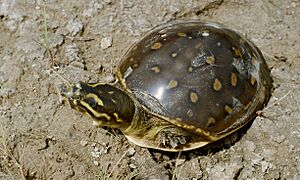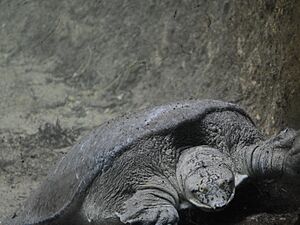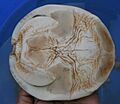Indian flapshell turtle facts for kids
Quick facts for kids Indian flapshell turtle |
|
|---|---|
 |
|
| Indian flapshell turtle at Rajaji National Park, India | |
| Conservation status | |
| Scientific classification | |
| Genus: |
Lissemys
|
| Species: |
punctata
|
| Subspecies | |
|
|
| Synonyms | |
|
|
The Indian flapshell turtle (Lissemys punctata) is a type of freshwater turtle that lives in South Asia. It gets its name from special skin flaps on its belly, called the plastron. These flaps can cover its legs when the turtle pulls them into its shell. Scientists are still learning how much these flaps protect the turtle from predators.
Indian flapshell turtles are very common in South Asia. They are an interesting link between softshell and hardshell water turtles. Sadly, these turtles face threats from people who hunt them for money and from changes to their natural homes.
Contents
About the Indian Flapshell Turtle
The shell of an adult Indian flapshell turtle, called the carapace, looks like a wide oval from above. Young turtles have a more circular shell. The shell is moderately curved. The edges of the shell are smooth and slightly flared at the back.
The turtle has a large head with a short, strong nose. Its claws are big and strong. The tail is very short in both male and female turtles.
The shell length of an Indian flapshell turtle can be from about 24 to 37 centimeters (9 to 14 inches). Males can grow up to 23 cm (9 in), while females can reach about 35 cm (14 in).
Conservation Status
In 1975, the Indian flapshell turtle was put on Appendix I of CITES. This list is for species that are highly endangered. However, later studies showed that this turtle was actually very common in India.
Because it was so common, the Indian flapshell turtle was removed from the endangered species list in 1983. In 1995, its status on the CITES list was changed to Appendix II. This means it is still protected, but not as strictly as before.
Where They Live
The Indian flapshell turtle can be found in several countries in South Asia. These include Pakistan, India, Sri Lanka, Nepal, Bangladesh, and Myanmar. They have also been introduced to the Andaman and Nicobar Islands.
These turtles are even found in the desert ponds of Rajasthan, India. Sometimes, many of them die there during the hot, dry summers. In 2020, a farmer found a rare yellow flapshell turtle. People believe it might be an albino version of the species.
Scientists have found fossils of this turtle in Nepal that are as old as the Miocene epoch.
Habitat and Ecology
What Do Indian Flapshell Turtles Eat?
The Indian flapshell turtle eats both plants and animals, which means it is omnivorous. Its diet includes frogs, shrimp, snails, and different kinds of water plants. They also eat plant leaves, flowers, fruits, grasses, and seeds.
Where They Live and Their Role in Nature
Lissemys punctata turtles prefer to live in shallow, calm, and often still waters. You can find them in rivers, streams, marshes, ponds, lakes, and even irrigation canals. They like places with sandy or muddy bottoms because they often dig and burrow into the mud.
These turtles help keep water clean. They do this by eating snails, insects, and pieces of dead animals. This makes them important for healthy water ecosystems.
How They Survive Dry Times
The Indian flapshell turtle is very good at surviving droughts, which are long periods without rain. They can dig into the ground or move from one water hole to another to avoid drying out. The special flaps on their legs also help them survive dry conditions.
During a drought, these turtles go into a state called estivation. This is like a deep sleep that helps them get through the dry period. Even though many turtles might die during droughts, some have been known to survive for up to 160 days!
Life Cycle and Reproduction
Indian flapshell turtles start to have babies when they are about 2 or 3 years old.
Nesting Habits
These turtles lay their eggs at different times of the year, depending on where they live. Usually, nesting happens from late summer into the monsoon season, which is around June to November. They often choose swampy areas with soil and sunlight for their nests.
Female turtles usually lay eggs two or three times a year. Each time, they lay between 2 and 16 eggs. They bury these eggs in the soil to keep them safe.
Dangers and Threats to Survival
Economic and Environmental Challenges
In many parts of South Asia, freshwater turtles and their eggs are eaten because they are a good source of protein. People often hunt these turtles to sell them for money. In Bangladesh and India, the Indian flapshell turtle is especially hunted because it is larger and has more meat than other turtles.
Because of conservation efforts, the price of turtle meat has gone up. This has led to more illegal hunting and selling of these animals internationally. Changes to the turtle's natural home also threaten them. Building dams, farming along river banks, and pollution are big dangers to their survival.
False Beliefs About Medicine
Some people believe that the shell of Lissemys punctata has medicinal uses. They grind the shell into a powder to make traditional medicines. However, there is no scientific proof that these beliefs are true. This is a myth that helps smugglers sell the turtles illegally.











